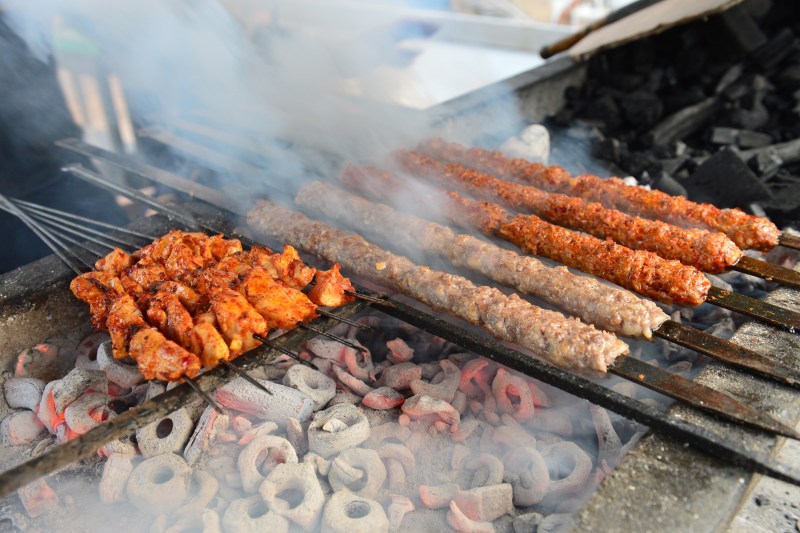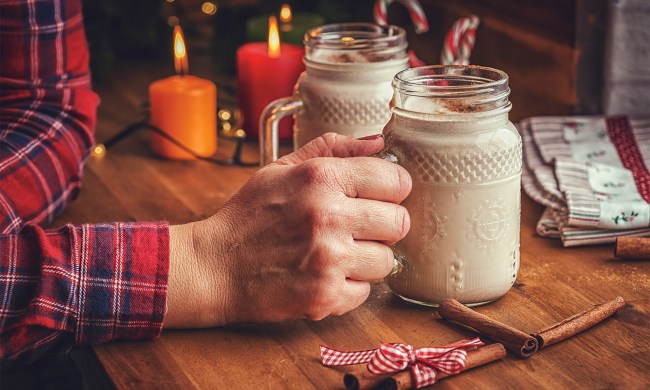
When it comes to kebabs, it’s rarely done better than in Indian cuisine. And at LORE in Park Slope, Brooklyn, Chef Jay Kumar is putting his distinctive spin on Indian kebabs and giving them a modern twist.
Using inspirations from his time spent in South India, Switzerland, and Brooklyn, Kumar is plating up classic Indian street food flavors with elegant presentation and sophisticated flavors. If you’re wondering why his kebabs aren’t on skewers, this is actually standard for some preparations. Certain types of kebabs, like the chapli, are shaped more like a spiced hamburger patty versus the typical meat skewer, and cooked in a large skillet. Quite simply, these are some of the best, one-of-a-kind Indian food recipes we’ve ever encountered.
Chicken “Afghan”

This kebab is inspired by the street food classic Chicken “Afghan.” Traditionally marinated in a mixture of garlic, pepper, and cumin, Kumar’s version is heightened with ingredients like ginger garlic paste and allspice. These crispy chicken pieces are then set atop a refreshing spiced cabbage thoran and creamy butternut squash puree, which is made slightly sweet with maple syrup.
Ingredients:
Ginger garlic paste:
- 1 cup fresh peeled fresh ginger, cut into chunks
- 1 cup peeled garlic
- ½ cup water
Combine the ginger, garlic and water in a blender and blend until smooth.
Chicken:
- 2 pounds of boneless chicken thighs, skin on
- 2 tablespoons sugar
- 1 teaspoon salt
Marinade:
- 2 tablespoons ginger garlic paste
- 1 teaspoon cumin powder
- 1 teaspoon coriander powder
- 2 teaspoons ground black pepper
- 1/2 teaspoon turmeric powder
- 1 teaspoon allspice powder
Squash:
- 2 butternut squash, peeled and cubed
- 2 Cippolini onions, peeled and quartered
- 1 teaspoon kosher salt
- About 3 tablespoons coconut oil
- 1 tablespoon maple syrup
- 1 teaspoon ground Kashmiri chili (or mild red chili powder)
- 1 teaspoon smoked paprika
- Coconut milk as needed
Cabbage thoran:
- 1 medium red cabbage
- 3 tablespoons coconut oil
- 1 large red onion sliced
- 1 teaspoon ginger garlic paste
- 1 teaspoon coriander powder
- 1 teaspoon cumin powder
- 1 teaspoon fennel powder
- 1 teaspoon chili powder
Sauce:
- 1 tablespoon coconut oil
- 1 large onion diced
- 2 tablespoons ginger garlic paste
- 1 cup coconut milk
- 1/2 cup cashew puree
- 1/2 teaspoon turmeric powder
- 1/2 teaspoon black pepper
- 1/2 teaspoon fennel powder
- 1/2 teaspoon cumin powder
- 1/2 teaspoon cardamom powder
Method:
For the chicken:
- Dry-brine chicken with sugar and salt, massaging thoroughly.
- Let sit for 10 minutes, then rinse, wash, and set aside.
- In a large bowl or plastic sealable bag, combine all the ingredients for marinade.
- Add chicken and coat thoroughly.
- Refrigerate for 24 hours.
For the squash puree:
- Preheat oven to 350 degrees Fahrenheit.
- Generously coat a sheet pan with coconut oil, then add squash and onions and toss with salt.
- Roast for 45 minutes.
- Raise temperature to 450 F and roast for an additional 15 minutes, then cool.
- Once the squash mixture is cool, add it to the blender or food processor with maple syrup, Kashmiri chili, and smoked paprika.
- Blend, adding a little coconut milk until you have a smooth puree.
- Set aside the squash and keep warm.
For the cabbage:
- Set a saucepan over medium heat and add coconut oil, red cabbage, sliced red onion, and ginger garlic paste, coriander, cumin, fennel, chili, and salt to taste.
- Cook, stirring occasionally until the onions are tender and and translucent, about 5 to 7 minutes.
- Set cabbage mixture aside and keep warm,
Roast the chicken:
- Preheat oven to 400 F.
- Place the chicken thighs on a sheet pan and roast for 14–18 minutes, or until the chicken is thoroughly cooked. The juices should run clear when the meat is gently pierced with the tip of a knife.
Make the sauce:
- In a small saucepan, heat the coconut oil over medium heat and add the onion and cook, stirring frequently until the onion is translucent, about 5 to 7 minutes.
- Add 2 tablespoons ginger garlic paste, turmeric, black pepper, fennel, cumin, and cardamom powder. Cook, stirring occasionally for 1 to 2 minutes, and add 1/2 cup cashew purée and 1 cup coconut milk and salt to taste until the sauce is warm.
To serve:
- Spread the squash purée on a plate and top with sauce.
- Layer the cabbage thoran on top of squash and top with additional sauce.
- Place chicken on top of cabbage and drizzle the last bit of sauce.
Chapli kebab

The chapli kebab is a favorite of northern India and Pakistan, and a classic among Indian recipes. A thin, crispy, and soft spiced meat patty, these kebabs are popular street food items. Kumar’s version includes briny Castelvetrano olives and tart black lime yogurt.
Ingredients:
Ginger garlic paste:
- 1 cup fresh ginger, peeled and cut into chunks
- 1 cup fresh peeled garlic
- 1/2 cup water
In a blender or food processor, combine the ginger, garlic and water and blend until smooth.
For the tomato chutney:
- 3 beefsteak tomatoes, diced
- 2 medium onions, diced
- 2 tablespoons coconut oil
- 1 tablespoon ginger garlic paste
- 1 tablespoon white balsamic vinegar
- 1 teaspoon sugar
- 1 teaspoon ground cumin
- 1 teaspoon ground coriander
- 1 teaspoon ground fennel
- 1 teaspoon paprika
- 1 teaspoon turmeric
- 1 teaspoon chili powder
- Salt and pepper to taste
For the black lime yogurt:
- 1 teaspoon black lime powder (if unavailable, substitute with a mixture of 1 teaspoon lemon juice and 1 teaspoon black pepper)
- 4 ounces plain Greek whole-milk yogurt
- 1 teaspoon minced garlic
- 1 tablespoon extra-virgin olive oil
- Salt and pepper to taste
Combine all the ingredients in a bowl and set aside until ready to use.
For the kebabs:
- 1 pound ground lamb shoulder
- 1/2 cup vegetable oil
- 1/2 cup ginger garlic paste
- 1/2 cup rice panko crumbs
- 1 tablespoon ground coriander
- 1 tablespoon ground cumin
- 1 teaspoon ground fennel
- 1 teaspoon red chili powder (kashmiri)-not american blend
- Additional vegetable oil for frying
For the garnish:
- Chopped cilantro, mint, parsley, and dill.
Method:
For tomato chutney:
- In a medium-sized, lidded saucepan, heat the coconut oil over medium heat and sauté the onions until translucent, stirring occasionally, about 5 to 7 minutes.
- Add ginger garlic paste, and sauté, stirring occasionally, about 1 minute.
- Add the tomatoes, cover, and cook, stirring occasionally for 5 minutes.
- Add the vinegar and sugar, stir, cover, and continue to cook.
- Stir occasionally, until tomatoes are soft, about 5 minutes
- Add cumin, coriander, fennel, paprika, turmeric, chili powder, salt, and pepper.
- Reduce heat to low and simmer for 30 minutes until thickened.
For the kebabs:
- Place all kebab ingredients in food processor and blend until smooth — do not over-process.
- Using wet or oiled hands, form eight palm-sized patties.
- Add vegetable oil to coat the bottom of a nonstick pan and heat over medium heat.
- Fry kebab patties until golden brown and fully cooked, about 6 minutes per side. Use a meat thermometer to make sure the patties have an internal temperature of 145 F.
To serve:
- Swirl black lime yogurt on plate.
- Add lamb kebab topped with tomato chutney.
- Garnish with cilantro, mint, parsley, and dill.



